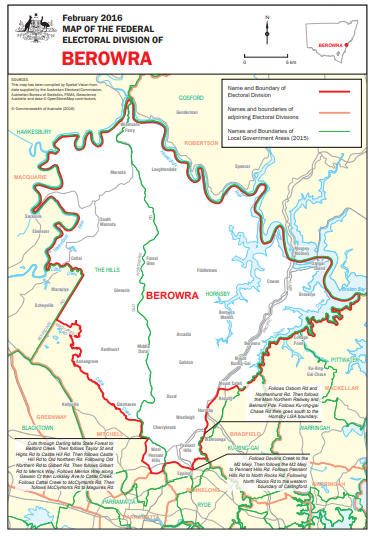|
|
|
|
| Adam Carr's Election Archive
|
Australian federal election, 2022
Division of Berowra, New South Wales
Named for: Sydney suburb of Berowra, located on Berowra Water (Indigenous name meaning "place of many shells")
Northern Sydney: Cherrybrook, Galston, Hornsby, Normanhurst, Pennant Hills
State seats: All of
Hornsby, parts of
Baulkham Hills,
Castle Hill,
Epping,
Hawkesbury and
Ku-Ring-Gai
Local government areas: Parts of
Hornsby,
Parramatta and
The Hills
Borders with:
Bennelong,
Bradfield,
Mackellar,
Macquarie,
Mitchell,
Parramatta and
Robertson
Enrolment at 2019 election: 106,331
Enrolment at 2022 election: 106,203 (-00.1)
1999 republic referendum: Yes 51.7
2018 same-sex marriage survey: Yes 54.6
Sitting member: Julian Leeser (Liberal):
Elected 2016, 2019
2007 Liberal majority over Labor: 8.9%
2010 Liberal majority over Labor: 16.2%
2013 Liberal majority over Labor: 19.1%
2016 Liberal majority over Labor: 16.5%
2019 Liberal majority over Labor: 15.6%
Liberal two-party vote 1983-2019
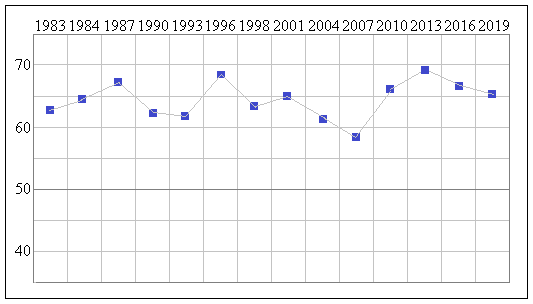
Status: Safe Liberal
Best Liberal booths, two-party vote: Maroota (87.5), Annangrove (82.9), Glenorie West (81.5), Kenthurst (81.3),
Maroota South (80.1)
Best Labor booths, two-party vote: Brooklyn (54.9), Cowan (48.4), Hornsby (46.6), Hornsby West (46.3), Normanhurst West (45.5)
2019 results
Statistics and history
Candidates in ballot-paper order:
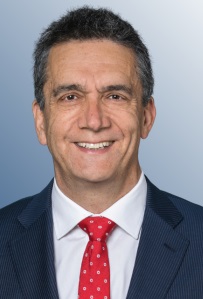 |
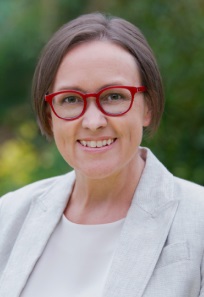 |
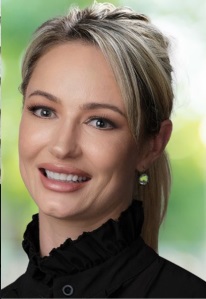 |
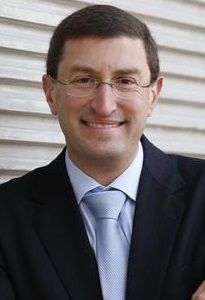 |
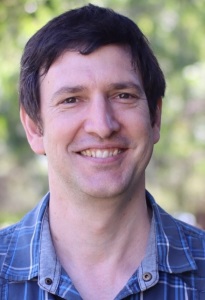 |
1. Nicholas Samios
Liberal Democrats |
2. Tania Salitra
Australian Greens |
3. Rhiannon Bosma
Pauline Hanson's One Nation |
4. Julian Leeser
Liberal Party |
5. Brendan Clarke
Fusion Party |
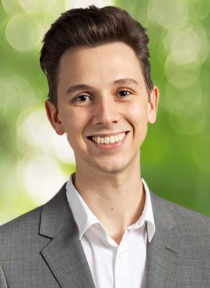 |
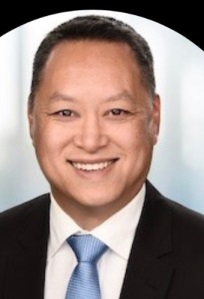 |
 |
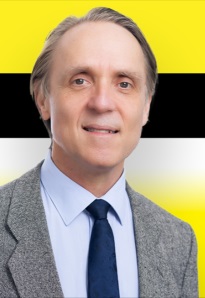 |
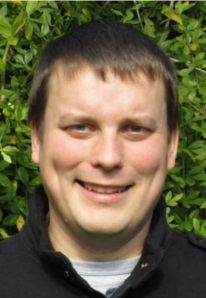 |
6. Benson Koschinski
Australian Labor Party |
7. David Louie
Australian Federation Party |
8. Roger Woodward
Independent |
9. Christopher Martinic
United Australia Party |
10. Benjamin Caswell
Independent |
Candidate websites:
Rhiannon Bosma
Benjamin Caswell
Brendan Clarke
Benson Koschinski
Julian Leeser
Christopher Martinic
Tania Salitra
Nicholas Samios
Division of Berowra
Berowra was created in 1969, in the fast-growing outer north-western suburbs of Sydney, and its boundaries have not
changed much since, although it has gradually expanded out to the north-west. It is one of the wealthiest seats in
Australia, with one of the highest levels of people in professional and managerial occupations, and also a high level
 of traditional families with children. It has the fourth-highest proportion of families with dependent children of
any electorate.
of traditional families with children. It has the fourth-highest proportion of families with dependent children of
any electorate.
These factors make Berowra a safe Liberal seat, and indeed Labor has never come close to winning it. In 2019 Labor won
only one booth, Brooklyn, which has 466 voters. There is some Labor strength in the Hornsby area, but in 2019 the Liberals won all
the Hornsby booths.
Previous members for Berowra have been
Tom Hughes, Attorney-General
in the Gorton government, and
Dr Harry Edwards, who had several stints on the opposition front bench but never achieved
office. He retired in 1993 and was succeeded by Phillip Ruddock.
Phillip Ruddock, Liberal MP for Parramatta from 1973 to 1977, for Dundas from 1977 to 1993 and for Berowra from 1993,
was a solicitor when he won the Parramatta by-election in 1973, aged 30. He sat out the Fraser Government, but was on
the opposition front bench from 1983. In the Howard Government he was first Immigration Minister and then Attorney-General.
In the Abbott Government he was Chief Government Whip until 2015. When he retired in 2016 he had been an MP for 43 years,
second only to
Billy Hughes as the longest-serving MP.
Julian Leeser, MP for Berowra since 2016, is a former staffer to both Ruddock and Abbott. Despite being of German-Jewish
descent, he was appointed Director of Government Policy and Strategy at the Australian Catholic University. Earlier he was
Executive Director of the Menzies Research Centre, a Liberal Party think-tank, and a member of Woollahra Municipal
Council - a perfect pedigree for an ambitious Liberal in a safe seat. The Greens candidate is Tania Salitra, whose occupation
is not stated.
Demographics:
Median weekly household income: $2,256 (Australia $1,438)
People over 65: 17.0% (Australia 15.8%)
Australian born: 64.1% (Australia 66.7%)
Ancestry: Chinese 9.1%
Non-English-speaking households: 30.0% (Australia 22.2%)
Catholics 23.7% (Australia 22.6%)
No religion 26.9% (Australia 29.6%)
University graduates: 35.4% (Australia 22.0%)
Professional and managerial employment: 48.6% (Australia 35.2%)
Employed in manufacturing and construction: 19.5% (Australia 22.9%)
Paying a mortgage: 41.7% (Australia 34.5%)
Renting: 14.5% (Australia 30.9%)
Traditional families: 50.3% (Australia 32.8%)
Back to main page
|
|
 of traditional families with children. It has the fourth-highest proportion of families with dependent children of
any electorate.
of traditional families with children. It has the fourth-highest proportion of families with dependent children of
any electorate. 
